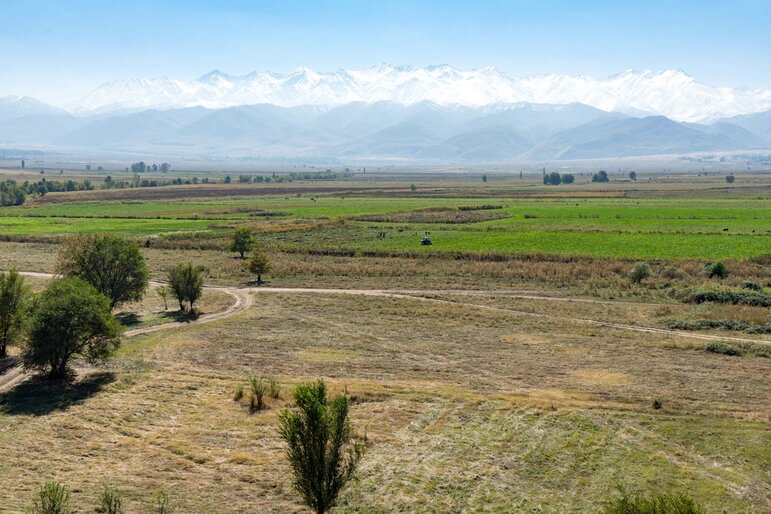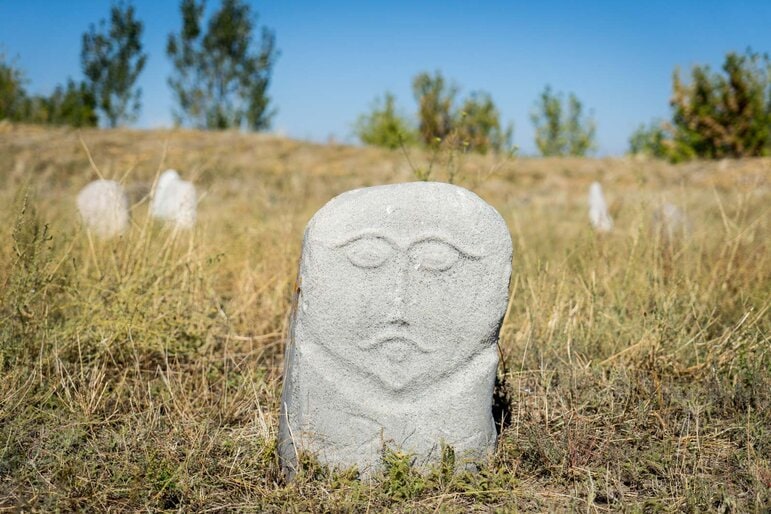Burana Tower, Kyrgyzstan
The steps are steep and I feel like I’m scrambling up almost vertically. One hand on a step above, one hand on the wall, I try to support myself and stop from falling backwards, down the path I’ve just come.
It’s dark and hard to see – which is not helping – but I take some comfort in knowing that this passageway is so small, I would probably get stuck before I tumbled the whole way to the bottom.

I wonder whether any of the people who built this staircase in a tower in the middle of Kyrgyzstan a thousand years ago ever fell down it. Perhaps you get to know each individual stair if you’re climbing up and down it multiple times every day.
That’s what people would once have done here because Burana Tower was built as a minaret, a spire that Islamic preachers would call out from the top of when it was time for prayers.
Nowadays there is nothing around it but once it would have risen up above a mosque in an ancient city called Balasagun.

Balasagun
As I get closer to the top, sunlight comes in through a hole above me and I can see the steps again. I climb up through the hole and I’m standing on the top of the tower, drenched in brightness again.
Looking around, I can see almost empty land stretching out in every direction. Between the 9th and 11th centuries, this area would have been filled with buildings – houses, bazaars, baths, shops – as part of Balasagun.
The city was the capital of a dynasty called Kara-Khanid Khanate that ruled a large swathe of Central Asia during this period.

This dynasty were big promoters of the relatively new religion of Islam and Burana Tower was one of the first minarets to be constructed in Central Asia.
It used to be 45 metres tall but has been damaged over the years by earthquakes and some of its bricks have been taken by locals for other construction projects. It’s now about 25 metres tall.


That’s high enough to get a good view and before I start back down the dark staircase, I take a final look around.
You can see a large square mound that would once have been some kind of palace or a temple (archaeologists aren’t sure). And the outlines of a few other structures.
Something that looks like a graveyard catches my eye and I decide that’s what I’ll go and look at when I get to the bottom.

Balbals
It turns out that what I had seen is not actually a graveyard – but it’s much more interesting than expected.
It is a collection of tombstones but without any bodies beneath. The stones have been collected from around the region and brought here for display.
What makes them so fascinating is that they are several hundreds years older than Burana Tower.


It seems as though each of the tombstones is looking up at me, staring, unblinking, as I wander between them. Stone faces that don’t move but say so much.


These tombstones are called ‘balbals’ and were made in around the 6th century. The idea is that a tombstone looks like the person who has died and often they were revered by future generations as symbols of ancestors.

I know that the people depicted here never lived in Balasagun, never set eyes on Burana Tower. But standing in the emptiness of an ancient city that has been reduced to almost nothing, I like that these stones are here.
I can imagine they are real people, residents here. It brings them and their new surrounds to life.






I appreciate that you wrote this post. I hope travel bloggers in India get their due soon. Yes, there should be good compensation for digital content creation. So stunning pics. Thank you so much for sharing it.
This looks amazing! I have always wanted to visit, and these photos make me want to go even more badly! Thank you so much for sharing it.
wow,what a great pictures you shared,you explore Burana Tower very well,i like your post so much,thanks to share it,every click make your blog interesting,glad to find your blog..
Great, that is awesome palce and full with beautiful things. You recommend so good things of that palce and statues are the best attraction of that place. So stunning photos you shared of that place.